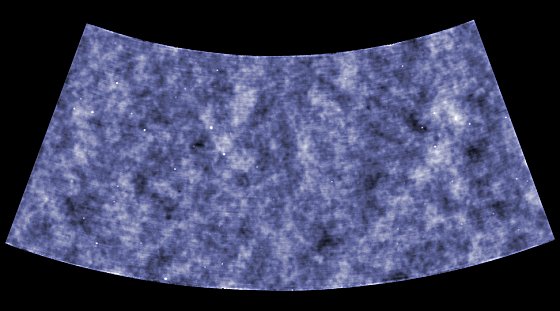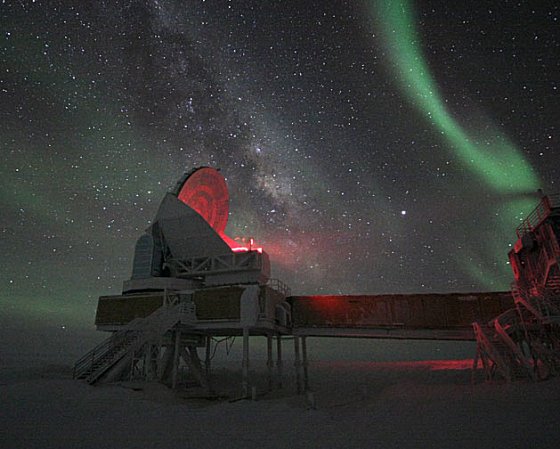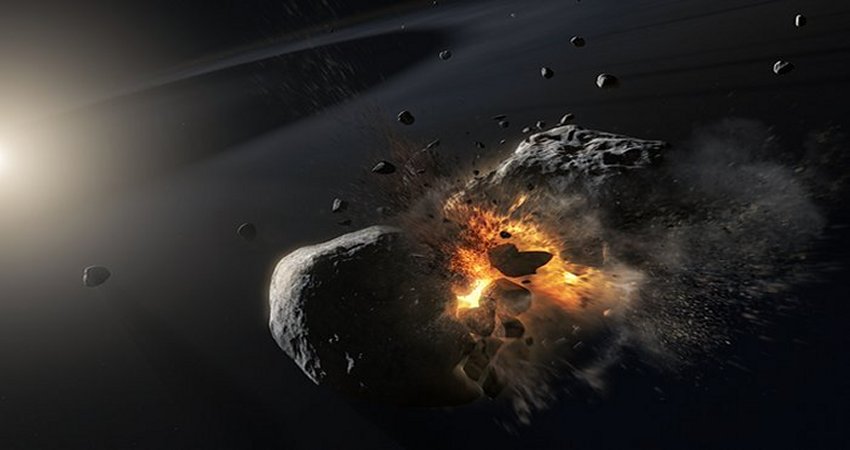Mysterious Force Responsible For Accelerating Expansion Of The Universe
MessageToEagle.com – The mysterious force is responsible for the accelerating expansion of the universe, according to analysis of data from the 10-meter South Pole Telescope (SPT).
The data strongly support Einstein’s cosmological constant, even though the analysis was based on only a fraction of the SPT data collected and only 100 of the over 500 galaxy clusters detected so far.
The results also are beginning to home in on the masses of neutrinos, the most abundant particles in the universe.
“With the full SPT data set we will be able to place extremely tight constraints on dark energy and possibly determine the mass of the neutrinos,” said Bradford Benson, a postdoctoral scientist at the University of Chicago’s Kavli Institute for Cosmological Physics.

This image displays a portion of the South Pole Telescope survey of the cosmic microwave background (CMB) – the radiant light left over from the Big Bang. Points of light mark quasars and gravitationally lensed galaxies. The variations in the image are minute fluctuations in the intensity of the CMB. The fluctuations are caused by differences in the distribution of matter in the early universe at a time only 400,000 years after the Big Bang. The image is effectively a “baby picture” of the universe. Credit: SPT Collaboration
“Right now, the forefront of physics is observational cosmology,” added Antony Stark (Harvard-Smithsonian Center for Astrophysics), co-principal investigator of the SPT. “We observe signs of dark energy, dark matter, and early inflation, but we don’t understand any of them. The South Pole Telescope’s mission is to provide some answers.”
The latest results are based on a new method that combines measurements taken by the SPT with those from orbiting X-ray satellites, and extends these measurements to larger distances than previously achieved using galaxy clusters.
The most widely accepted property of dark energy is that it leads to a pervasive force acting everywhere and at all times in the universe. This force could be the manifestation of Einstein’s cosmological constant, which he considered to be one of his greatest blunders after learning that the universe is expanding.
Einstein introduced the factor into his general theory of relativity to accommodate a stationary universe, the dominant idea of his day. But his constant fits nicely into the context of an accelerating universe, now supported by countless astronomical observations. Others hypothesize that gravity could operate differently on the largest scales of the universe. In either case, the astronomical measurements are pointing to new physics that has yet to be understood.

The SPT was specifically designed to tackle the dark energy mystery. The 10-meter telescope operates at millimeter wavelengths to make high-resolution images of the cosmic microwave background (CMB) – the light left over from the Big Bang. Scientists use the CMB in their search for distant, massive galaxy clusters that can be used to pinpoint the properties of dark energy and the mass of the neutrino.
“The CMB is literally an image of the universe when it was only 400,000 years old, from a time before the first planets, stars and galaxies formed in the universe,” Benson said. “The CMB has travelled across the entire observable universe, for almost 14 billion years, and during its journey is imprinted with information regarding both the content and evolution of the universe.”
As the CMB passes through galaxy clusters, the clusters effectively leave “shadows” that allow astronomers to identify the most massive clusters in the universe, nearly independent of their distance.
“Clusters of galaxies are the most massive, rare objects in the universe, and therefore they can be effective probes to study physics on the largest scales of the universe,” said John Carlstrom of the University of Chicago, who heads the SPT collaboration.
The number of clusters that formed over the history of the universe is sensitive to the influence of dark energy on the growth of cosmic structures, as well as the mass of neutrinos. If they are too massive, they would significantly affect the formation of galaxies and galaxy clusters.
The SPT team has now placed tight limits on neutrino masses, yielding a value that approaches predictions stemming from particle physics measurements.
This release is being issued jointly with the University of Chicago and Bradford Benson is presenting the SPT collaboration’s latest findings on Sunday, April 1, at the American Physical Society meeting in Atlanta.
MessageToEagle.com via cfa.harvard.edu
Related Posts
-
 Extraterrestrial Life In Space And Smelly, Toxic Gas On Earth As A Crucial Biosignature
No Comments | Dec 23, 2019
Extraterrestrial Life In Space And Smelly, Toxic Gas On Earth As A Crucial Biosignature
No Comments | Dec 23, 2019 -
 It Wasn’t A Planet But An Expanding Dust Cloud From A Cosmic Collision
No Comments | Apr 21, 2020
It Wasn’t A Planet But An Expanding Dust Cloud From A Cosmic Collision
No Comments | Apr 21, 2020 -
 Collision Between Two Milky Way Satellite Galaxies – Confirmed
No Comments | Oct 26, 2018
Collision Between Two Milky Way Satellite Galaxies – Confirmed
No Comments | Oct 26, 2018 -
 Two Exoplanets Directly Observed Growing Around A Young Star
No Comments | Jun 10, 2019
Two Exoplanets Directly Observed Growing Around A Young Star
No Comments | Jun 10, 2019 -
 Cycle Of Spectacular Disturbances At Jupiter’s Equator – Identified
No Comments | Dec 21, 2018
Cycle Of Spectacular Disturbances At Jupiter’s Equator – Identified
No Comments | Dec 21, 2018 -
 10 Great Space Images: Quizz: How Well Do You Know Your Space Photos?
No Comments | Nov 26, 2015
10 Great Space Images: Quizz: How Well Do You Know Your Space Photos?
No Comments | Nov 26, 2015 -
 Mars’ Moon Phobos Is Slowly Falling Apart
No Comments | Nov 11, 2015
Mars’ Moon Phobos Is Slowly Falling Apart
No Comments | Nov 11, 2015 -
 Mysterious Interstellar Object Oumuamua Is Not What We Expected – New Theory Suggests
No Comments | Apr 16, 2020
Mysterious Interstellar Object Oumuamua Is Not What We Expected – New Theory Suggests
No Comments | Apr 16, 2020 -
 Attempt To Explain Enigmatic Gigantic Troughs On Vesta
No Comments | Sep 27, 2012
Attempt To Explain Enigmatic Gigantic Troughs On Vesta
No Comments | Sep 27, 2012 -
 VLA And ALMA Study Jupiter And Io That Can Solve Some Mysteries Of Our Own Solar System
No Comments | Dec 18, 2022
VLA And ALMA Study Jupiter And Io That Can Solve Some Mysteries Of Our Own Solar System
No Comments | Dec 18, 2022
